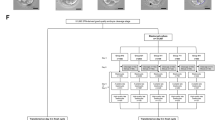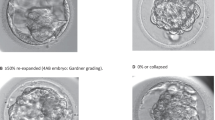Abstract
Purpose
To determine the developmental competence of fast-cleaving D3 embryos.
Methods
Retrospective study including 4028 embryos from 513 PGT-A cycles performed between July 2014 and June 2017. Embryos were cultured in time-lapse incubators and biopsied at blastocyst stage. Embryos were classified in groups according to the number of cells on D3 (from 2-cell to ≥13 -cell and compacted). A generalized linear mixed model adjusted for confounding factors was performed to assess the chance to give rise to an euploid blastocyst in each group compared with the chance of 8-cell embryos. Implantation and live birth rates were also analyzed.
Results
The statistical analysis showed that embryos with 9 to 11 cells had a slightly lower euploid blastocyst rate than 8-cell embryos (OR (95% CI) 0.77 (0.61–0.96)) while embryos with more than 11 cells were found to be just as likely to give rise to an euploid blastocyst as the 8-cell embryos (OR (95% CI) 1.20 (0.92–1.56)). Conversely, slow-cleaving embryos had a significantly lower euploid blastocyst rate than 8-cell embryos (OR (95% CI) 0.31 (0.24–0.39)). Moreover, euploid blastocysts derived from fast-cleaving embryos and from 8-cell embryos exhibit similar live birth rates. No significant differences were found in the chance to give rise a live birth between 8-cell and 9- to 11-cell embryos (OR (95% CI) 1.23 (0.70–2.15)) and > 11-cell embryos (OR (95% CI) 1.09 (0.57–2.09)).
Conclusions
Embryos with more than 11 cells exhibit similar developmental competence to 8-cell embryos. Their poor prognosis should be reconsidered.


Similar content being viewed by others
References
Racowsky C, Jackson KV, Cekleniak NA, Fox JH, Hornstein MD, Ginsburg ES. The number of eight-cell embryos is a key determinant for selecting day 3 or day 5 transfer. Fertil Steril. 2000;73:558–64.
Alpha Scientists in Reproductive Medicine and ESHRE Special Interest Group of Embryology. The Istanbul consensus workshop on embryo assessment: proceedings of an expert meeting. Hum Reprod. 2011;26:1270–83.
Cuevas Saiz I, Pons Gatell MC, Cuadros Vargas M, Delgado Mendive A, Rives Enedáguila N, Moragas Solanes M, et al. The embryology interest group: updating ASEBIR’s morphological scoring system for early embryos, morulae and blastocysts. Med Reprod Embriol Clín. 2018;5:42–54.
Racowsky C, Stern JE, Gibbons WE, Behr B, Pomeroy KO, Biggers JD. National collection of embryo morphology data into Society for Assisted Reproductive Technology Clinic Outcomes Reporting System: associations among day 3 cell number, fragmentation and blastomere asymmetry, and live birth rate. Fertil Steril. 2011;95:1985–9.
Shapiro BS, Harris DC, Richter KS. Predictive value of 72-hour blastomere cell number on blastocyst development and success of subsequent transfer based on the degree of blastocyst development. Fertil Steril. 2000;73:582–6.
Langley MT, Marek DM, Gardner DK, Doody KM, Doody KJ. Extended embryo culture in human assisted reproduction treatments. Hum Reprod. 2001;16:902–8.
Luna M, Copperman AB, Duke M, Ezcurra D, Sandler B, Barritt J. Human blastocyst morphological quality is significantly improved in embryos classified as fast on day 3 (>or=10 cells), bringing into question current embryological dogma. Fertil Steril. 2008;89:358–63.
Kong X, Yang S, Gong F, Lu C, Zhang S, Lu G, et al. The relationship between cell number, division behavior and developmental potential of cleavage stage human embryos: a time-lapse study. PLoS One. 2016;11:e0153697.
Magli MC, Gianaroli L, Ferraretti AP, Lappi M, Ruberti A, Farfalli V. Embryo morphology and development are dependent on the chromosomal complement. Fertil Steril. 2007;87:534–41.
Finn A, Scott L, O’Leary T, Davies D, Hill J. Sequential embryo scoring as a predictor of aneuploidy in poor-prognosis patients. Reprod BioMed Online. 2010;21:381–90.
Kroener LL, Ambartsumyan G, Pisarska MD, Briton-Jones C, Surrey M, Hill D. Increased blastomere number in cleavage-stage embryos is associated with higher aneuploidy. Fertil Steril. 2015;103:694–8.
Barri PN, Martinez F, Coroleu B, Tur R. The role of GnRH antagonists in assisted reproduction. Reprod BioMed Online. 2002;5(Suppl 1):14–9.
Gardner DK, Schoolcraft WB. In vitro culture of human blastocyst. Jansen R Mortimer Eds Reprod certain Infertil genet 1999. Carnforth: Parthenon Press; 1999. p. 378–388.
Veiga A, Sandalinas M, Benkhalifa M, Boada M, Carrera M, Santaló J, et al. Laser blastocyst biopsy for preimplantation diagnosis in the human. Zygote. 1997;5:351–4.
Kuwayama M, Vajta G, Ieda S, Kato O. Comparison of open and closed methods for vitrification of human embryos and the elimination of potential contamination. Reprod BioMed Online. 2005;11:608–14.
MacKenna A, Crosby J, Zegers-Hochschild F. Embryo early cleavage, number of blastomeres and morphology at day three as factors to predict blastocyst development. JBRA Assist Reprod. 2013;17:158–61.
Meseguer M, Herrero J, Tejera A, Hilligsøe KM, Ramsing NB, Remohí J. The use of morphokinetics as a predictor of embryo implantation. Hum Reprod. 2011;26:2658–71.
Motato Y, de los Santos MJ, Escriba MJ, Ruiz BA, Remohí J, Meseguer M. Morphokinetic analysis and embryonic prediction for blastocyst formation through an integrated time-lapse system. Fertil Steril. 2016;105:376–384.e9.
Giorgetti C, Terriou P, Auquier P, Hans E, Spach JL, Salzmann J, et al. Embryo score to predict implantation after in-vitro fertilization: based on 957 single embryo transfers. Hum Reprod. 1995;10:2427–31.
Ziebe S, Petersen K, Lindenberg S, Andersen AG, Gabrielsen A, Andersen AN. Embryo morphology or cleavage stage: how to select the best embryos for transfer after in-vitro fertilization. Hum Reprod. 1997;12:1545–9.
Petersen BM, Boel M, Montag M, Gardner DK. Development of a generally applicable morphokinetic algorithm capable of predicting the implantation potential of embryos transferred on day 3. Hum Reprod Oxf Engl. 2016;31:2231–44.
Carrasco B, Arroyo G, Gil Y, Gómez MJ, Rodríguez I, Barri PN, et al. Selecting embryos with the highest implantation potential using data mining and decision tree based on classical embryo morphology and morphokinetics. J Assist Reprod Genet. 2017;34:983–90.
Sunde A, Brison D, Dumoulin J, Harper J, Lundin K, Magli MC, et al. Time to take human embryo culture seriously. Hum Reprod. 2016;31:2174–82.
Rubio I, Galán A, Larreategui Z, Ayerdi F, Bellver J, Herrero J, et al. Clinical validation of embryo culture and selection by morphokinetic analysis: a randomized, controlled trial of the EmbryoScope. Fertil Steril. 2014;102:1287–1294.e5.
Kovacic B, Vlaisavljević V. Influence of atmospheric versus reduced oxygen concentration on development of human blastocysts in vitro: a prospective study on sibling oocytes. Reprod BioMed Online. 2008;17:229–36.
Kirkegaard K, Hindkjaer JJ, Ingerslev HJ. Effect of oxygen concentration on human embryo development evaluated by time-lapse monitoring. Fertil Steril. 2013;99:738–744.e4.
Acknowledgements
This work was performed under the auspices of “Càtedra d’Investigació en Obstetricia i Ginecologia” of Department of Obstetrics, Gynaecology and Reproductive Medicine; Hospital Universitari Dexeus, Universitat Autònoma de Barcelona.
Author information
Authors and Affiliations
Contributions
M.C.P. and B.C. designed the study, interpreted the data, and wrote the manuscript. M.P., M.B., and A.V. edited and reviewed the manuscript. S.G. conducted the statistical analysis. I.G-F, B.C., and P.B. reviewed the manuscript. All authors approved the final version of the manuscript.
Corresponding author
Ethics declarations
Conflict of interest
The authors declare that they have no conflict of interest.
Additional information
Publisher’s note
Springer Nature remains neutral with regard to jurisdictional claims in published maps and institutional affiliations.
Electronic supplementary material
Supplemental Table 1
(DOCX 63.2 kb)
Supplemental Table 2
(DOCX 12.9 kb)
Supplemental Table 3
(DOCX 53.5 kb)
Supplemental Table 4
(DOCX 27.1 kb)
Rights and permissions
About this article
Cite this article
Pons, M.C., Carrasco, B., Parriego, M. et al. Deconstructing the myth of poor prognosis for fast-cleaving embryos on day 3. Is it time to change the consensus?. J Assist Reprod Genet 36, 2299–2305 (2019). https://doi.org/10.1007/s10815-019-01574-y
Received:
Accepted:
Published:
Issue Date:
DOI: https://doi.org/10.1007/s10815-019-01574-y




